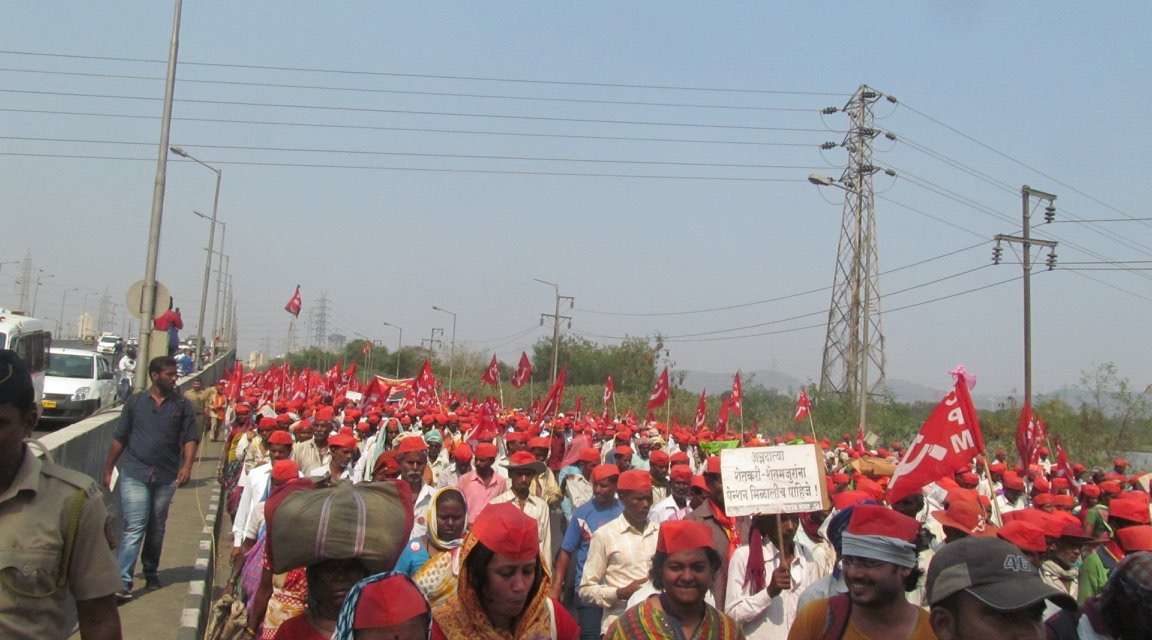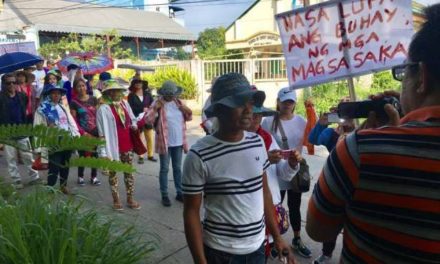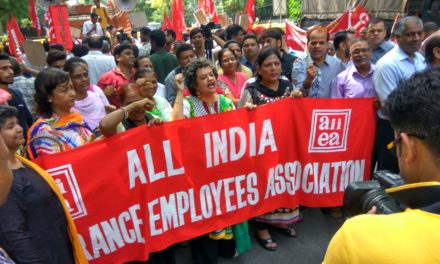India – 12th March 2018 will be remembered as red-letter day in the history of farmers’ movement in Maharashtra. At the dawn of this day, a red sea of more than 50,000 farmers, laborers, and indigenous people arrived in Mumbai with blistered feet, swollen knees, and bleeding soles from a 200-kilometer walk, yet they were enthusiastic and quite hopeful to get what they came here for. It was an unprecedented peasants’ March—the longest so far in the history of peasant marches in the State of Maharashtra. Mainstream and social media, as well as the entire country’s attention, was on the farmers and the action received support from political parties and civil society organizations across the political spectrum (excluding the ruling party) at a time when farmer’s issues were being largely ignored.
The Long March, supported by the All India Kissan Sabha (AIKS), commenced a week before on March 6thin the Nasik District of Maharashtra with more than 25,000 farmers. Among them were thousands of women carrying red flags, banners, and placards, wearing red caps and chanting revolutionary slogans. As the march was moving gradually from Nasik, more and more people joined on the route to Mumbai. By the time the march entered Mumbai’s adjacent city of Thane on the morning of 11th March, the marchers have swelled to 50,000. No mass protest in the recent past has had such nationwide impact as this peasants’ march.
The protest action was a manifestation of the severe agrarian crisis in the agricultural belt of Maharashtra. Agrarian crisis in India has been an age-old concern, but it got aggravated in the post-liberalization period, by anti-peasant policies of the state. The neo-liberal policies in the early-1990s have had a severe impact on Indian agriculture, which had seen more than 300,000 suicides by farmers, including a large number from Maharashtra. The state support for agriculture and rural development has since been dwindling, resulting in a disproportionate impact on poor agricultural laborers, socially marginalized groups, and small landowners. The public expenditure for agriculture has either slowed down or stagnated, while massive cuts in subsidies in real term year after year have been undertaken. Moreover, there has been a significant reduction of public investment in agricultural research, extension, and irrigation. The neo-liberal policies have benefitted the rich and capitalist farmers and large landlords more than the peasants.
Increased frequency of peasant protests
Prior to this historical march, the country has already witnessed constant agitation and strikes by the farmers against the Central and the State governments. Since the current NDA (National Democratic Alliance) government led by Bhartiya Janta Party (BJP) came into power in May 2014, there have been series of protests by the farmers in Maharashtra between 2015 and 2018. Some of the major ones were: Peasant Rights Awareness Campaign in October 2015; Sit-in at Satyagraha (Non-Cooperation) in March 2016; Coffin Rally in 2016; Siege Protest against the Tribal Minister in October 2016; Farmers’ Strike in June 2017, when for the first time in the history of farmers’ struggle in India, farmers in Maharashtra went on strike and decided to stop the supply of their produce. Farmers blocked major highways in different cities, spilled milk on the street, threw away the vegetables, and stopped the supply of agricultural produce to major cities. At that time, the state government assured that farmer’s demands would be met soon; however, the state did not keep its promise.
Farmers’ concerns: non-agenda for government
Before this long march, in the recent past, the state’s inability to implement what had been promised has resulted in a severe crisis, triggering anger in rural Maharashtra. The crisis aggravated since 2015 when the newly formed State government by the BJP, which also ruled at the Centre, irresponsibly dealt with the farmers’ concerns. In September 2017, when another BJP-ruled State Uttar Pradesh announced loan waivers for its farmers, this triggered a strong demand for loan waiver in Maharashtra and other states of India. During the farmers’ strike in June 2017, the Chief Minister of Maharashtra declared that a farm loan of Rs.34000 crores (approx 5.23 billion US dollars) would be waived off, which would benefit more than 89 lakhs (8.9 million) of farmers in the State. However, this announcement proved mere political gimmick and was never fulfilled.
The currency crunches in November 2016 due to the demonetization (withdrawal of 500 and 1000 rupees currency notes) scheme came as a nightmare for the farmers as they were not able to sell agricultural produce in the market or purchase agricultural inputs for the next crop. The currency alteration also had an impact on the Cooperative banking in the rural area as these banks have been the primary source of crop loan for farmers. The access to institutional credit from these banks was halted and hence farmers had to rely heavily on private moneylenders, resulting into extreme indebtedness among small and marginal farmers.
The granting of an assured support price policy (called Minimum Support Price or MSP in India) has been another lie of the government. One of the major recommendations of the MS Swaminathan Commission was that farmers be paid at least 50 percent premium over and above the total cost of cultivation. The National Commission for Farmers was set up by the Government of India in 2006 under the chairmanship of an eminent agricultural scientist – M S Swaminathan. The BJP in its 2014 Election Manifesto promised to implement the Commission report but no action has been taken after coming into power. Even though in the Union Budget of 2018-19, the Finance Minister announced that the minimum support price will be set as recommended by the Swaminathan Commission, the Budget was not clear about which cost would be considered. Every year, the Commission for Agricultural Cost and Prices sets minimum support price for selected Rabi (June-Oct) and Kharif (Nov-April) season crops based on three different production costs, i.e. Cost A2 – actual paid out cost, Cost A2+FL –paid out cost-plus imputed family labour cost, and cost C2 – imputed cost on rent and interest on owned land and capital. The 2006 Commission recommended for Cost C2 as a base cost for the minimum support price. However, until today, the government has not come out openly in support of Cost C2 and this issue has been mired in controversy.
Meanwhile, farmers are suffering since they sell their produce at very low prices, sometimes much lower than their cost of production. Because the minimum support price fixed by the government does not even cover their actual cost and the traders never offer the MSP to farmers because there are no effective mechanisms to strictly implement MSP and the private traders take advantage of this situation.
Farmers in Maharashtra are also suffering because NAFED (National Agricultural Cooperative Marketing Federation of India Ltd.), an apex organization of marketing cooperatives for agricultural produce in India, always delay in procurement from farmers for at least two to three months after harvest and as a result, farmers fail to get their return immediately after harvest. NAFED procures directly from the farmers at the minimum support price. The procurement centers are supposed to purchase from the farmers immediately after the harvest but they never open on time, and these delays was another major reason that fuelled the crisis.
During the sequential droughts between the years 2013 to 2015, farmers had suffered crop loss, badly affecting crop productivity. Last year again, thousands of farmers in Maharashtra suffered from crop loss due to pest attack, unseasonal rainfall, and hailstorm. Yet, the State government did not announce any compensation scheme that would help to recover their loss to some extent.
In the tribal belt of Nasik, Palghar and Thane districts, the major demand has been for the implementation of the Forest Right Act 2006. The tribals have been cultivating forest land for the last three generations but the land has yet to be legally transferred in their name.
State response
The Maharashtra government underestimated the strength of the Kisan Long March until it got massive media coverage and public support across the country. On 12th March, after a three-hour long discussion between the Chief Minister, related Ministry officials, and the AIKS leaders, most of the farmers’ demands and concerns were addressed and a concrete time-bound (six months) written assurance was signed by the State’s Chief Secretary, accepting the demands related to the implementation of the Forest Rights Act (FRA); reconsideration of proposed river linking project; issuance of loan waiver to farmers; institution of rice incentives as recommended by the Swminathan Commission; legal entitlement to and regularization of pasture lands; stoppage of land acquisition without farmers’/ tribal consent; re-issuance of ration cards in tribal villages, and; compensation for farmers who have suffered from natural calamities.
For many farmers in Maharashtra and around the country, this was not the end of the farmers’ protests. It was rather the beginning because this will give strength and vigour to many such farmers groups and movements to come together and take their issues with the government more effectively but in a disciplined manner as the Maharashtra farmers did.









